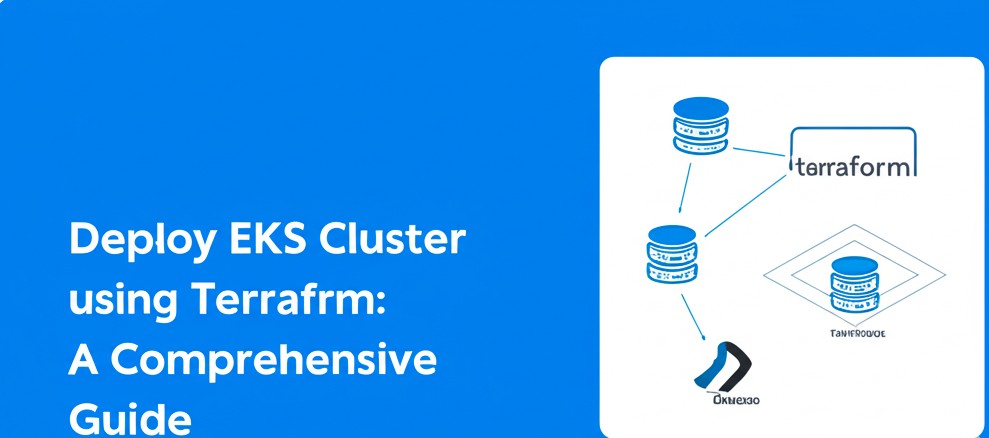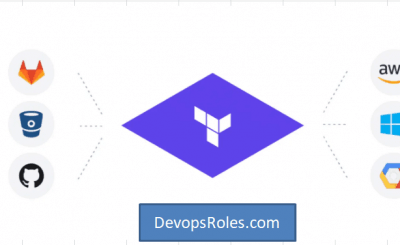Managing Kubernetes clusters can be complex, requiring significant expertise in networking, security, and infrastructure. This complexity often leads to operational overhead and delays in deploying applications. This comprehensive guide will show you how to streamline this process by leveraging Terraform, a powerful Infrastructure as Code (IaC) tool, to automate the Deploy EKS Cluster Terraform process. We’ll cover everything from setting up your environment to configuring advanced cluster features, empowering you to build robust and scalable EKS clusters efficiently.
Table of Contents
- 1 Prerequisites
- 2 Setting up the Terraform Configuration
- 3 Deploying the EKS Cluster Terraform Configuration
- 4 Configuring Kubernetes Resources (Post-Deployment)
- 5 Advanced Configurations
- 6 Frequently Asked Questions
- 6.1 Q1: How do I handle updates and upgrades of the EKS cluster using Terraform?
- 6.2 Q2: What happens if I destroy the cluster using `terraform destroy`?
- 6.3 Q3: Can I use Terraform to manage other AWS services related to my EKS cluster?
- 6.4 Q4: How can I integrate CI/CD with my Terraform deployment of an EKS cluster?
- 7 Conclusion
Prerequisites
Before embarking on this journey, ensure you have the following prerequisites in place:
- An AWS account with appropriate permissions.
- Terraform installed and configured with AWS credentials.
- The AWS CLI installed and configured.
- Basic understanding of Kubernetes concepts and EKS.
- Familiarity with Terraform’s configuration language (HCL).
Refer to the official Terraform and AWS documentation for detailed installation and configuration instructions.
Setting up the Terraform Configuration
Our Deploy EKS Cluster Terraform approach begins by defining the infrastructure requirements in a Terraform configuration file (typically named main.tf). This file will define the VPC, subnets, IAM roles, and the EKS cluster itself.
Defining the VPC and Subnets
We’ll start by creating a VPC and several subnets to host our EKS cluster. This ensures network isolation and security. The following code snippet demonstrates this:
# Data source to get available availability zones
data "aws_availability_zones" "available" {
state = "available"
}
# Main VPC resource
resource "aws_vpc" "main" {
cidr_block = "10.0.0.0/16"
enable_dns_hostnames = true
enable_dns_support = true
tags = {
Name = "eks-vpc"
}
}
# Private subnets
resource "aws_subnet" "private" {
count = 2
vpc_id = aws_vpc.main.id
cidr_block = cidrsubnet(aws_vpc.main.cidr_block, 8, count.index)
availability_zone = data.aws_availability_zones.available.names[count.index]
map_public_ip_on_launch = false
tags = {
Name = "eks-private-subnet-${count.index}"
Type = "Private"
}
}
# Optional: Public subnets (commonly needed for EKS)
resource "aws_subnet" "public" {
count = 2
vpc_id = aws_vpc.main.id
cidr_block = cidrsubnet(aws_vpc.main.cidr_block, 8, count.index + 10)
availability_zone = data.aws_availability_zones.available.names[count.index]
map_public_ip_on_launch = true
tags = {
Name = "eks-public-subnet-${count.index}"
Type = "Public"
}
}
# Internet Gateway for public subnets
resource "aws_internet_gateway" "main" {
vpc_id = aws_vpc.main.id
tags = {
Name = "eks-igw"
}
}
# Route table for public subnets
resource "aws_route_table" "public" {
vpc_id = aws_vpc.main.id
route {
cidr_block = "0.0.0.0/0"
gateway_id = aws_internet_gateway.main.id
}
tags = {
Name = "eks-public-rt"
}
}
# Associate public subnets with public route table
resource "aws_route_table_association" "public" {
count = length(aws_subnet.public)
subnet_id = aws_subnet.public[count.index].id
route_table_id = aws_route_table.public.id
}Creating IAM Roles
IAM roles are crucial for granting the EKS cluster and its nodes appropriate permissions to access AWS services. We’ll create roles for the cluster’s nodes and the EKS service itself:
# IAM policy document for EC2 to assume the role
data "aws_iam_policy_document" "assume_role" {
statement {
actions = ["sts:AssumeRole"]
principals {
type = "Service"
identifiers = ["ec2.amazonaws.com"]
}
}
}
# EKS Node Instance Role
resource "aws_iam_role" "eks_node_instance_role" {
name = "eks-node-instance-role"
assume_role_policy = data.aws_iam_policy_document.assume_role.json
tags = {
Name = "EKS Node Instance Role"
}
}
# Required AWS managed policies for EKS worker nodes
resource "aws_iam_role_policy_attachment" "eks_worker_node_policy" {
policy_arn = "arn:aws:iam::aws:policy/AmazonEKSWorkerNodePolicy"
role = aws_iam_role.eks_node_instance_role.name
}
resource "aws_iam_role_policy_attachment" "eks_cni_policy" {
policy_arn = "arn:aws:iam::aws:policy/AmazonEKS_CNI_Policy"
role = aws_iam_role.eks_node_instance_role.name
}
resource "aws_iam_role_policy_attachment" "ec2_container_registry_read_only" {
policy_arn = "arn:aws:iam::aws:policy/AmazonEC2ContainerRegistryReadOnly"
role = aws_iam_role.eks_node_instance_role.name
}
# Optional: Additional policy for CloudWatch logging
resource "aws_iam_role_policy_attachment" "cloudwatch_agent_server_policy" {
policy_arn = "arn:aws:iam::aws:policy/CloudWatchAgentServerPolicy"
role = aws_iam_role.eks_node_instance_role.name
}
# Instance profile for EC2 instances
resource "aws_iam_instance_profile" "eks_node_instance_profile" {
name = "eks-node-instance-profile"
role = aws_iam_role.eks_node_instance_role.name
tags = {
Name = "EKS Node Instance Profile"
}
}
# Output the role ARN for use in other resources
output "eks_node_instance_role_arn" {
description = "ARN of the EKS node instance role"
value = aws_iam_role.eks_node_instance_role.arn
}
output "eks_node_instance_profile_name" {
description = "Name of the EKS node instance profile"
value = aws_iam_instance_profile.eks_node_instance_profile.name
}Deploying the EKS Cluster
Finally, we define the EKS cluster itself. This includes specifying the cluster name, version, VPC configuration, and node group details:
resource "aws_eks_cluster" "main" {
name = "my-eks-cluster"
role_arn = aws_iam_role.eks_node_instance_role.arn
vpc_config {
subnet_ids = aws_subnet.private.*.id
}
enabled_cluster_log_types = ["api", "audit", "authenticator"]
}
Deploying the EKS Cluster Terraform Configuration
After defining the configuration, we can deploy the cluster using Terraform. This involves initializing the project, planning the deployment, and finally applying the changes:
terraform init: Initializes the Terraform project and downloads the necessary providers.terraform plan: Creates an execution plan, showing the changes that will be made.terraform apply: Applies the changes, creating the infrastructure defined in the configuration file.
Configuring Kubernetes Resources (Post-Deployment)
Once the EKS cluster is deployed, you can utilize tools like kubectl to manage Kubernetes resources within the cluster. This includes deploying applications, managing pods, and configuring services. You’ll need to configure your kubeconfig file to connect to the newly created cluster. This is typically downloaded after the EKS cluster is created through the AWS console or using the AWS CLI.
Advanced Configurations
This basic setup provides a functional EKS cluster. However, more advanced configurations can be implemented to enhance security, scalability, and manageability. Some examples include:
- Node Groups: Terraform allows for managing multiple node groups with different instance types and configurations for better resource allocation.
- Auto-Scaling Groups: Integrating with AWS Auto Scaling Groups allows for dynamically scaling the number of nodes based on demand.
- Kubernetes Add-ons: Deploying add-ons like the Amazon EKS managed node groups for easier node management can improve cluster efficiency and reduce operational overhead.
- Security Groups: Implement stringent security rules to control network traffic in and out of the cluster.
Frequently Asked Questions
Q1: How do I handle updates and upgrades of the EKS cluster using Terraform?
Terraform can manage updates to your EKS cluster. After upgrading the Kubernetes version through the AWS console or CLI, re-running `terraform apply` will reflect the changes in your Terraform configuration. However, ensure your Terraform configuration is up-to-date with the latest AWS provider version.
Q2: What happens if I destroy the cluster using `terraform destroy`?
Running `terraform destroy` will remove all the infrastructure created by Terraform, including the EKS cluster, VPC, subnets, and IAM roles. This action is irreversible, so proceed with caution.
Yes, Terraform’s versatility extends to managing various AWS services associated with your EKS cluster, such as CloudWatch for monitoring, IAM roles for fine-grained access control, and S3 for persistent storage. This allows for comprehensive infrastructure management within a single IaC framework.
Q4: How can I integrate CI/CD with my Terraform deployment of an EKS cluster?
Integrate with CI/CD pipelines (like GitLab CI, Jenkins, or GitHub Actions) by triggering Terraform execution as part of your deployment process. This automates the creation and updates of your EKS cluster, enhancing efficiency and reducing manual intervention.

Conclusion
This guide provides a solid foundation for deploying and managing EKS clusters using Terraform. By leveraging Infrastructure as Code, you gain significant control, repeatability, and efficiency in your infrastructure management. Remember to continuously update your Terraform configurations and integrate with CI/CD pipelines to maintain a robust and scalable EKS cluster. Mastering the Deploy EKS Cluster Terraform process allows for streamlined deployment and management of your Kubernetes environments, minimizing operational burdens and maximizing efficiency.
For more in-depth information, consult the official Terraform documentation and AWS EKS documentation. Additionally, explore advanced topics like using Terraform modules and state management for enhanced organization and scalability.
Further exploration of using AWS provider for Terraform will be greatly beneficial. Thank you for reading the DevopsRoles page!
